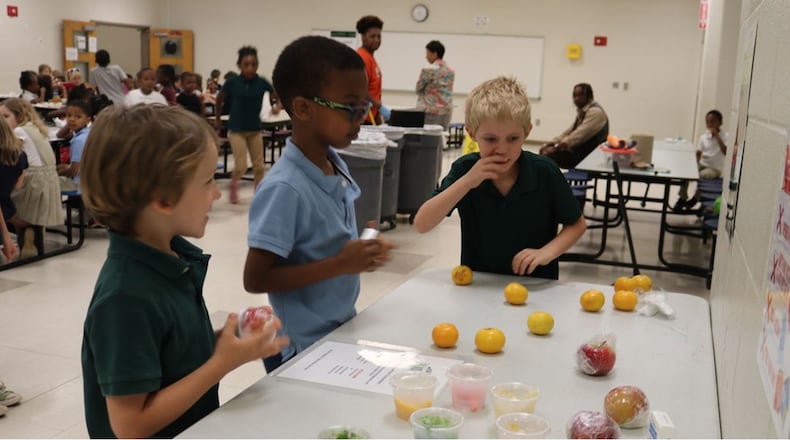Every day, food goes to waste at many Atlanta schools.
At least one school, though, is doing something about it.
Recently school officials at Parkside Elementary School in Atlanta started a program, which allows students who get lunches through the meal program to put their unopened juices and some fruit on a common share table called the “Panda Pantry.”
Then, students who are still hungry can get items like an extra banana or juice box.
At times, Jenna Moore Colvin has gone to Parkside to have lunch with her 7-year-old son, Nathan. She’s often noticed how much food ended up in the trash can.
“It can help the other kids who might be a little bit hungrier,” said the Grant Park resident. “It’s a creative way to help people and reduce waste. It’s like a win-win.”
Indeed, more attention is being paid to food waste — from schools to restaurants, retailers and in the home.
Although the school year is ending, Parkside Principal Timmy Foster hopes the school can repeat the program, which was started by a group of parents, next school year. He got district approval to implement the program.
Related: Cheers for Atlanta businesses' efforts to combat food waste
He said the school, which has an enrollment of 624 students ranging from pre-K to fifth grade, was only able to implement it on a small scale because of district stipulations on how to store the food, which foods could be shared and whether other students could participate.
None of the shared food comes from home. Students can share items like apples, oranges, bananas, unopened juice boxes and unopened packages. Banned are things like opened packages and dairy.
As most parents know, children can be picky eaters, especially when it comes to fruits and vegetables.
Some students at Parkside also take earlier lunches, so they may not be as hungry at the time. Studies have shown that eating lunch after recess can help reduce waste, according to the USDA.
“If students want to take an additional apple or three apples to take home and share with their families, that’s OK so we’re not throwing away so much food,” Foster said. He also wants to explore ways to share some of the uneaten food with homeless shelters.
“Schools throw away a lot of food,” he said. “We want to make sure we offer choices for kids, but in doing so, a lot of food goes to waste. We’re teaching kids about not wasting food and also understanding that there are people who don’t have the luxury to being able to eat when they want to.”
Share tables aren’t new, but there has been an increase over the past several years as new school meal guidelines were introduced.
According to the New York-based Natural Resources Defense Council, 40 percent of the food produced in the United States is wasted. That waste amounts to $218 billion annually, said Margaret Brown, staff attorney for the NRDC.
Related: Mind the waste: Rethinking leftovers and throwaways
Related:CPA firms in major food fight — for charity
“The Atlanta Public Schools Nutrition Department established the share table initiative at Parkside Elementary School this year as a pilot program, the results of which will be studied and evaluated at the end of the school year,” said spokesman Ian Smith. “The goal of the program is not only to reduce waste, but also to provide needy families with healthy, supplemental food options.”
Anastasia Carter, then a public health intern at Georgia State University and an alumnus of Parkside, spearheaded implementation of the program.
As part of her internship, Carter said she noticed more than two dozen trash bags filled with cartons and food collected each day from the cafeteria. One time, she counted more than 20 bananas; 215 unopened milk cartons and more than 100 juice boxes in the trash bin.
Students, she said, “would grab two drinks and throw one away,” she said.
Once the Panda Pantry was instituted, “by the end of the period, the share table is empty,” Carter said. “Kids can learn the importance of eating nutritious foods instead of throwing them away. They can see other kids going up to the share table.”
You might be surprised about what becomes waste. Consider supermarkets that might discard badly bruised fruits and vegetables or foods that don’t look appealing. Or restaurant patrons that don’t finish meals. Or farmers who might grow too much of a certain crop.
There are cookbooks designed to cut down on waste. It’s not just the food itself that’s wasted. Experts say the cost of food wasted extends to the retail level, water, energy, fertilizers, production and transportation costs. And most of that food waste ends up in landfills.
The Ad Council, in partnership with the Natural Resources Defense Council, launched a media campaign that included print and television ads warning against wasting food.
About half of schools in the DeKalb County School District participate in share table programs, most in after-school programs, according to spokeswoman Eileen Houston-Stewart.
Items shared include unopened prepackaged cereal bars, graham crackers and milk and whole fruits and vegetables.
“It’s been very successful,” said Houston-Stewart. “Otherwise, that food would just go in the trash. From what we’ve been able to see and what cafeteria managers tell us, there doesn’t appear to be any kind of stigma associated with this.”
About the Author
Keep Reading
The Latest
Featured



